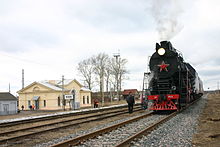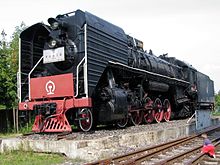SŽD series ЛВ
| SŽD series ЛВ | |
|---|---|
|
ЛВ18-002
|
|
| Numbering: | different numbering |
| Number: | 522 |
| Manufacturer: | Luhansk locomotive factory |
| Year of construction (s): | 1952-1956 |
| Retirement: | Mid 1970s |
| Axis formula : | 1'E1 'h2 |
| Gauge : | 1524 mm |
| Length: | 14,789 mm |
| Height: | 5120 mm |
| Width: | 3222 mm |
| Empty mass: | 109.8 t |
| Service mass: | 121.5 t |
| Friction mass: | 90.1 t / 98.6 t |
| Wheel set mass : | 18.0-18.2 t |
| Top speed: | 85 km / h |
| Indexed performance : | ~ 2420-2600 hp |
| Starting tractive effort: | ~ 214 kN |
| Driving wheel diameter: | 1500 mm |
| Impeller diameter front: | 900 mm |
| Rear wheel diameter: | 1050 mm |
| Control type : | Heusinger |
| Number of cylinders: | 2 |
| Cylinder diameter: | 650 mm |
| Piston stroke: | 800 mm |
| Boiler overpressure: | 14 bar |
| Grate area: | 6.46 m² |
| Superheater area : | No. 1: 136.5 m² further: 149.2 m² |
| Evaporation heating surface: | 236.9 m² |
| Tender: | four-axis type п58 |
| Service weight of the tender: | empty 36 t (four-axle) 54.85 t (6-axle) |
| Water supply: | 28 m³ (4-axis) 45.6 m³ (6-axis) |
| Fuel supply: | 18 t (4-axle) 23.5 t (6-axle) |
| Particularities: |
Boxpok -wheelsets stoker -fire pneumatic adjustability of the friction weight |
The SŽD class ЛВ (German transcription LW) was a steam locomotive of the Soviet Railways (SŽD) in Russian broad gauge . It is considered to be the last mass-produced steam locomotive of the SŽD and was preferably used in freight train service nationwide on non-electrified routes. It was named after the chief designer of the Kolomna Locomotive Works , Lev Sergeyevich Lebedjanski associated with the contraction of the Manufacturer: W oroschilowgrad. Before this name, it was called OP 18 (October Revolution, axle load 18 t).
prehistory
After the Second World War , the operation of freight trains on less resilient main lines was mainly handled by the Л series freight locomotives . This machine showed good dynamic properties and good load characteristics. The collective of designers received the Stalin Prize for their work .
It also had some drawbacks. The most important was their weight distribution. There were also disadvantages due to their axle arrangement; the lack of a trailing axle led to poor running characteristics when driving the tender ahead. That is why the idea of developing a steam locomotive based on the Л series with the 1'E1 'wheel arrangement arose as early as 1948.
Design and construction
In 1949, the Luhansk locomotive factory began planning the new steam locomotive. It received an additional trailing axle based on the model of the ФД series . In addition, it received another preheater for the boiler feed water , which resulted in a larger boiler. In addition, the chassis has been reinforced at some points to increase the reliability of the construction in operation.
In October 1951, the production of the first prototype locomotive, OP 18-01, was completed in the factory. After receiving their papers, testing of the locomotive began. In doing so, she achieved astonishing values; peak performance of up to 3590 hp could be achieved, which was 12% more than with the SŽD series ФД and 14% more than with the diesel locomotive ТЭ3 . The locomotive was able to develop 19.8% more tractive power than the Л series. At the same time the highest efficiency of all steam locomotives of the SŽD was measured with the prototype locomotive , -9.27%.
In 1953 the second prototype locomotive, the OP 18-02 , was made, which received a few minor changes compared to the prototype. At the beginning of 1954, the plant delivered the third prototype locomotive and in the same year the fourth, followed in the same year by the first 6 pre-series locomotives. With these, the locomotives received their new designation ЛB . Series locomotives were manufactured in the Luhansk locomotive factory from 1955 . That year 112 machines were manufactured, in 1956 400 machines were manufactured. The series locomotives showed some changes compared to the prototype locomotives, the most important of which was the occasional equipment with the six-axle tender of the type п58 series , identical to that of the SŽD series П36 . As a result, the coupling box for the connection between the locomotive and tender had to be reinforced, which increased the weight of the locomotive.
According to the original plan, it was assumed that around 3000 steam locomotives of the ЛВ series would be produced . With the successful introduction of the series ТЭ3 diesel locomotive , however, the decision was made to no longer manufacture steam locomotives, so that the ЛB-0522 manufactured in 1956 was also the last steam locomotive manufactured in the USSR . The machines had no consecutive numbering, so the four-digit serial number had a two in the first place, but the last locomotive had the designation ЛB-0522 .
technical description
The construction of the ЛВ steam locomotive is much similar to the Л series, only more perfect and sophisticated. The increase in the additional support axis allowed the introduction of many additional elements, such as B. Zugfunk , Indusi and the like. Some elements could also be installed in the boiler to further increase the efficiency of the locomotive.
The frame of the locomotive is like the locomotives of the series ФД and series Л a bar frame with a wall thickness of 140 mm. Many elements of the frame were surface treated for increased durability. Many elements, such as the cast cylinder block and the coupling box for connecting the locomotive to the tender, ensured the additional durability of the frame. A few lateral intermediate fastenings also ensured the durability of the frame.
The locomotive's boiler was constructed in the same way as that of the Л series, i.e. analogous to the design principles according to Sergej Petrovich Siromyatnikov, supplemented with some improvements, such as additional preheating for the boiler feed water . The boiler was welded and consisted of 4 sections. Compared to the Л series, the grate area was increased by 7%, which was achieved by widening the grate. The length of the grate was analogous to the Л series. The evaporation area of the kettle was increased from 222.3 m² to 236.9 m², which was achieved by enlarging the cylindrical part. The superheater area also increased from 113.5 m² to 126.5 m² for the first prototype locomotive and 149.2 m² for the other locomotives. The improvement of the combustion process was achieved by extending the smoke chamber, thereby increasing the draft. The grate was designed as a shaking grate .
Like the Л series, the steam engine was a two-cylinder machine with a cylinder diameter of 650 mm and a piston stroke of 800 mm. The steam cylinders were made from two cast blanks that were connected to a block with the help of a bolt. In addition, they were connected to the upper part of the frame and served as a support for the boiler. The slides had a diameter of 330 mm and were designed as Trofimoff slides . The control was designed as a Heusinger type . The locomotives' wheelsets were designed as boxpok wheelsets. The third drive axle of the locomotive was the drive axle of the locomotive and was firmly mounted in the frame. The first, second and fifth coupling axles had a lateral displacement of +/- 40 mm, the fourth coupling wheel axle a lateral displacement of +/- 14 mm. As with the SŽD series ФД, the running axles were rotatably mounted according to the Bissel system , the trailing axle was externally mounted so as not to obstruct the ash pan. The front had a deflection of +/- 125 mm, the rear +/- 105 mm. The suspension was designed according to the principle of the SŽD series ФД, the machine supported itself on three points. The running gear of the locomotive allowed the weight to be shifted from the towing axle to the rear coupling axle through a pneumatic device, and thus a control of the friction weight.
business
As already mentioned, the first prototype locomotives were subjected to operational tests from 1953 to 1954. It was used on the railway of the Moscow - Kursk region together with a steam locomotive of the ФД series. In the process of these tests, the locomotive brought the following results: the mean weight of the train for the steam locomotive ЛВ18-001 was 2% greater than for the ФД . For heavy trains, a performance increase of 8.7% was achieved. The locomotive ЛВ18-001 consumed an average of 24.9% less coal than the ФД .
This resulted in the field of application of the locomotive; the locomotive was able to provide the services of the ФД on routes that were not passable with this (due to the axle load of 18 t). For the detailed use of the vehicles, see the website of the locomotive.
With all positive results of the locomotive there were also difficulties. In the case of the locomotives with the six-axle tender, the length of the entire locomotive was approx. 28 m (for the series Л it was 23 m), so that it could only be turned in depots that also had a turntable of 30 m diameter. That was not the case at the time. In practice, the locomotives could not prevent the structural change. The somewhat weaker ТЭ3 was already under construction when it was built. In addition, the main train of the Transsib was electrified in the year , and this shifted the area of operation more in a northeasterly direction. In addition to freight train service, many locomotives were also used in passenger train service, only vehicles with the four-axle tender were used.
At the end of the 1960s, the locomotives were gradually transferred to the reserve. As of January 1, 1976, there were still 521 steam locomotives nationwide, namely on the Northern Railway (168 locomotives), in Kazakhstan (209 locomotives), in Sverdlovsk (35 locomotives), in the Urals region (34 locomotives) and Western Siberia (75 locomotives) . After the boiler deadline , the locomotives were taken out of service.
Further development
When the locomotive was built, 3000 locomotives were required. The result was the stronger version of the ЛВ , the SŽD series ОР21 with an axle load of 21 t, which was intended as a replacement for the SŽD series ФД . Due to the structural change, only three copies were built.
But even after the structural change, the construction of steam locomotives was not over. Based on the ЛВ , the CNR series QJ steam locomotive was later built in China and was manufactured until 1988.
Whereabouts
Many locomotives have also survived from this locomotive; six vehicles are operational for the operation of special trains; two vehicles have been preserved, eleven locomotives are in museums and one as a memorial. Even four vehicles should still be present as a torso.






